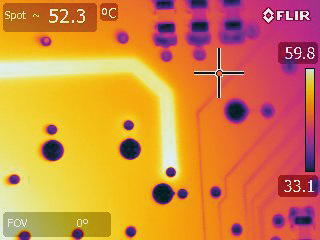
Detecting Temperature Differences on PCB Components
Product News Tuesday, September 20, 2016: FLIR Systems
FLIR Systems announces a new applications article that describes how leading Dutch embedded electronics specialist – 3T is using a FLIR thermal imaging camera to detect hot spots of less than 125 x 125 microns in size that may indicate a PCB component is likely to fail.
When something goes wrong in a PCB, whether it is improper soldering of a circuit or a failing component, the PCB will heat up. Therefore, thermal imaging offers a very good way to diagnose problems in the design phase of a PCB, to test it before it is supplied to a customer or in the qualification stage.
The traditional alternative to using thermal imaging for fault diagnosis in PCB electronics has been to use thermocouples. Unlike thermocouple measurements that require contact with the PCB board, thermal imaging is a non-contact temperature measurement technology that does not risk disturbing or damaging microelectronic components.
Using a FLIR T420 thermal imaging camera with 50µm close-up lens, the application article describes how 3T is now able to focus upon and routinely study the performance of individual microelectronic components in their printed circuit boards.
The article also describes how using FLIR ResearchIR software the 3T engineers have been able to make high speed video recordings and perform advanced thermal pattern analysis on one-time thermal events. Using this software 3T engineers are now able to better analyze PCB hot spots and find thermal peaks.
The FLIR T420 is an affordable thermal imaging camera that combines excellent ergonomics with top performance and high image quality. The FLIR T420 comes with a tiltable optical unit which makes it possible to measure and take images of objects at all angles, while still operating in a comfortable working position. To download a copy of the full article please visit www.flir.co.uk/cs/display/?id=63575 .
